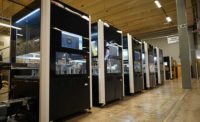Cobots Automate Electronics Assembly

Lubomir Ferenc, application technologist at Marelli, programs a UR cobot.
Photo courtesy Universal Robots
The best high-speed pick-and-place machines for circuit board assembly can place an astonishing 100,000 surface-mount components an hour with an accuracy of ±0.04 millimeter. That’s a lot of chips!
And yet, even today, some 40 years after the surface-mount revolution in electronics assembly, there remain some components, such as connectors, that defy attempts at standardized automation. Electronics assembly lines around the world invariably feature a handful of workers manually installing connectors, transformers, capacitors and other odd-form components.

Marelli’s products include lighting systems, powertrain control systems, telematics systems and electronic instrument clusters. Photo courtesy Marelli Holdings Co. Ltd.
Such was the case at the Kechnec, Slovakia, assembly plant owned by Marelli Holdings Co. Ltd.
Formed in 2019, by the merger of Italian multinational company Magneti Marelli with Japanese multinational Calsonic Kansei, Marelli Holdings is now one of the largest automotive suppliers in the world. Employing some 43,000 people, the company operates 86 factories, 12 R&D centers and 26 application centers across 19 countries. The company’s products include lighting systems, body control systems, powertrain control systems, electronic instrument clusters, telematics systems, computers, suspension systems and components, exhaust systems, heat exchangers, compressors, and climate control systems.
Located near Slovakia’s border with Hungary, approximately 150 miles northwest of Budapest, the Kechnec plant opened in 2008 and assembles automotive control units, instrument clusters, and infotainment and telematics systems. The plant operates 16 surface-mount assembly lines and one final assembly line. Some 800 people work at the factory, which operates 24/7.
Like many electronics assembly plants, the Kechnec factory employed several people at the end of line to install plastic connectors and other components into circuit boards. The task was slow, monotonous and prone to error. Factory engineers wanted to automate the process, but standard electronics assembly equipment could not handle the task due to the size, shape and orientation of the parts.
That’s when Lubomír Graca, head of the technology department at the factory, decided to give collaborative robots from Universal Robots a shot.

Marelli uses cobots to insert connectors and other odd-form components into circuit boards. Photo courtesy Universal Robots
“We found an effective solution in the cobots from Universal Robots,” says Graca. “We were pleasantly surprised by the ease of installation and programming of the cobots, the UR+ [family of products], and the support of the system integrator. UR+ products are plug-and-play technologies and certified to work seamlessly with UR cobots.”
The factory uses four UR cobots to insert the components into boards. UR10, UR5 and UR5e cobots pick individual components, such as connectors and through-hole components, directly from the supplier’s packaging. The robots are equipped with the RG2 collaborative gripper from OnRobot, which is certified as a UR+ product.
“The UR robot has replaced an operator who performed manual placing of connectors,” says Lubomir Ferenc, application technologist. “This monotonous work induced many mistakes, such as uneven connector placing and not pushing connectors in properly. The UR robot is faster and more accurate. The operator no longer has to perform this monotonous task, and he can be assigned to a more sophisticated job, such as operation of pick-and-place machines or printers.”

A cobot equipped with an RG2 collaborative gripper from OnRobot installs a connector. Photo courtesy Universal Robots
Assembly Line Speed Boosted by 25 Percent
Cobots have minimized the risks of poor handling of components and circuit boards. At the same time, assembly line speed has been accelerated by 25 percent.
“Because of the installation of collaborative robots on the assembly line, it’s safe for humans to work around it,” says Graca. “Our employees are working with the cobots regularly, and they are glad that it has relieved them of monotonous repetitive work.”
Indeed, the staff loves the cobots so much, they even gave them names. Marelli saw a return on investment in the cobots, even with the mechanics of the whole station, within one year. One cobot was able to replace operators on four shifts. Quality issues have been eliminated.
“After our experience and successful implementation of cobots, we plan to extend their use on all of our assembly lines, and we are constantly looking for other applications where we could use the cobots,” explains Graca.
For more information on collaborative robots, click www.universal-robots.com.

Cobots have increased assembly line speed by 25 percent. Photo courtesy Universal Robots
ASSEMBLY ONLINE
For more information on robotic assembly, read these articles:
Human-Robot Collaboration Comes of Age
Collaborative Robots Help Finish Cars at Ford Assembly Plant in Germany
Cobots Create Value at Cummins
Looking for a reprint of this article?
From high-res PDFs to custom plaques, order your copy today!






